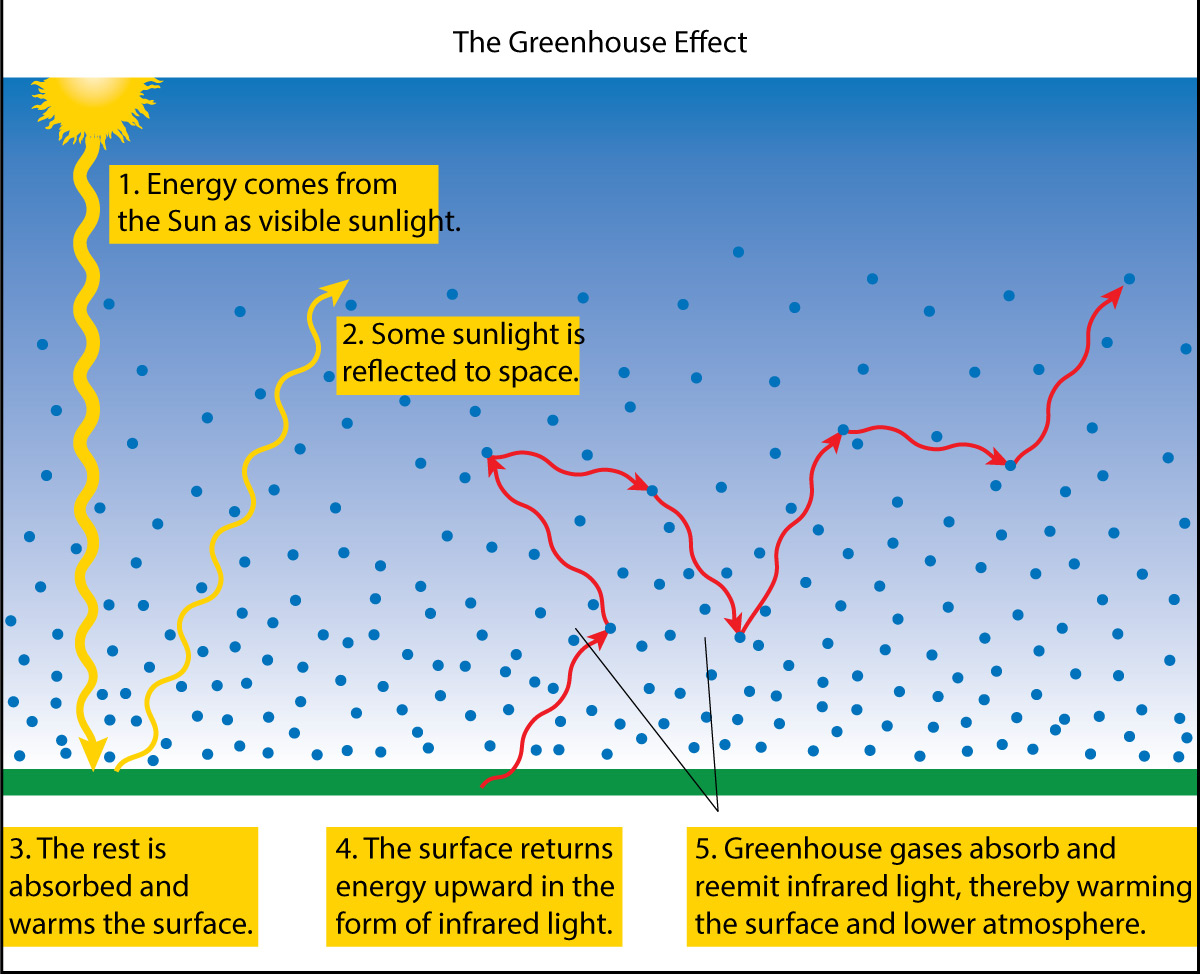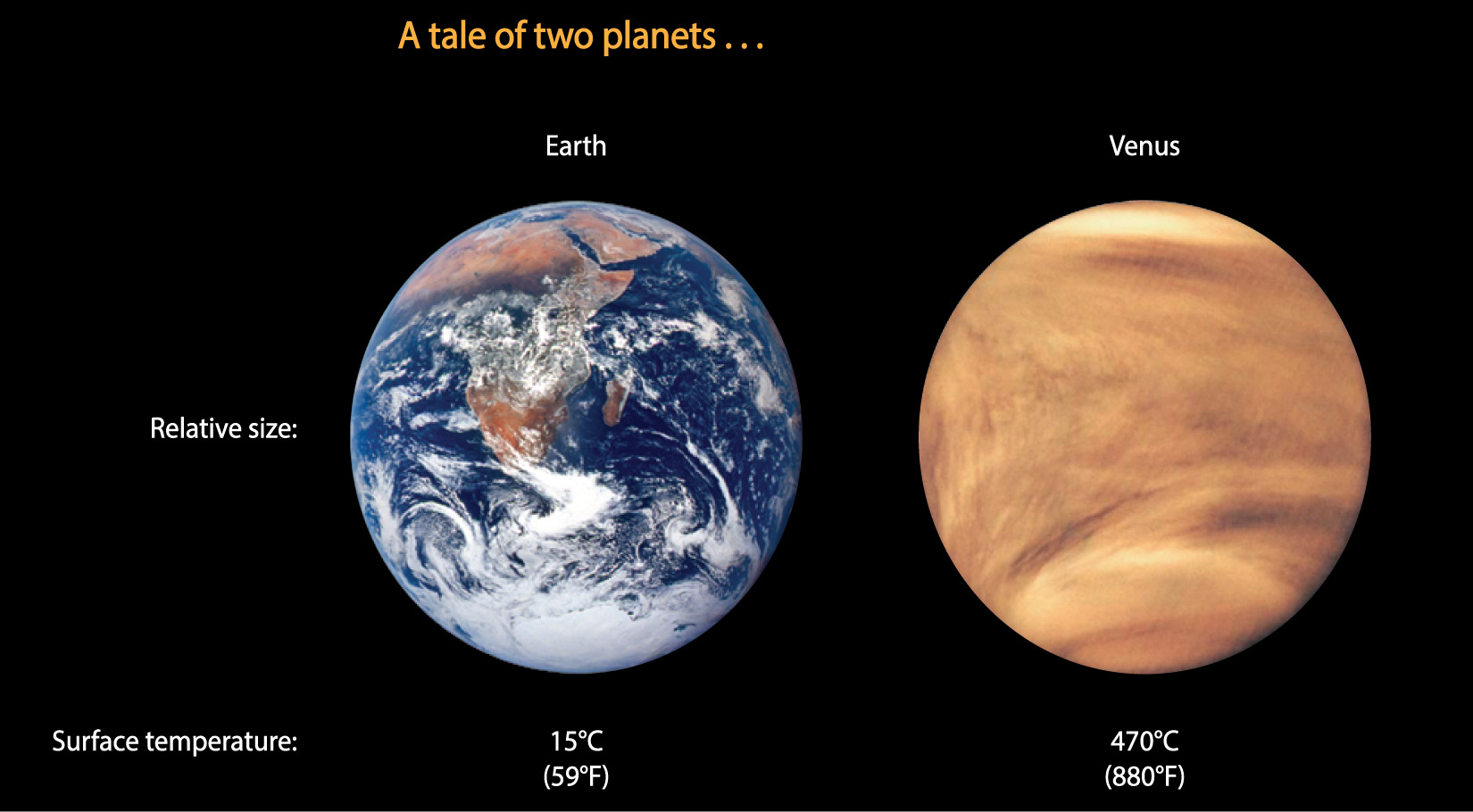
Consider again our “tale of two planets” (repeated above). Notice that Venus’s surface temperature of 470°C (880°F) is extremely hot compared to Earth. In fact, it is not only hotter than a pizza oven, but hot enough to melt lead. This high temperature (along with the very high pressure) explains why no spacecraft has been able to survive for more than a couple hours on the surface of Venus (Figure 7.1.1–2).
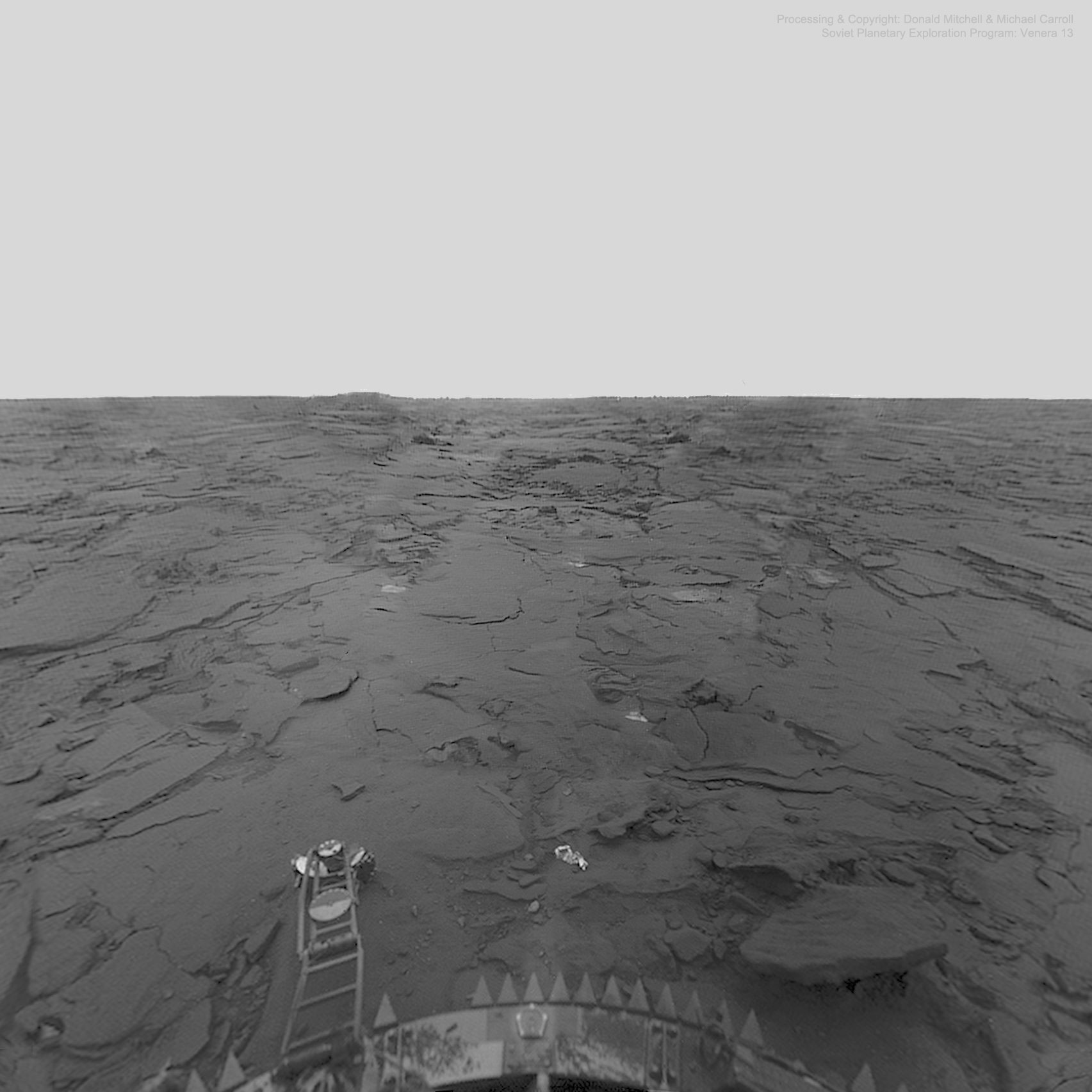
Why is Venus so much hotter than Earth, given that the two planets are otherwise about as close to being “twin” planets as is possible? Recall (from Section 3.3.1) that, in science, we try to answer a question like this is by first forming a hypothesis , or tentative explanation, then looking for ways that we can test the hypothesis to see if it works. In this case, the first hypothesis that most people try is that Venus’s high temperature is a result of it being closer than Earth to the Sun.
However, with a little thought, it is pretty easy to see that this first hypothesis does not work. Figure 7.1.1–3 shows part of the Voyage Scale Model Solar System, which is the 1-to-10-billion scale model of the solar system that we introduced in Section 1.2.3. Notice that while it’s obviously true that Venus is closer to the Sun, the difference isn’t really all that great. As the following activity shows, the difference is certainly not enough to account by itself account for why Venus is so much hotter than Earth .

Activity
Feel the Heat
Try one of the following two options to help you understand why Venus’s closer distance to the Sun cannot by itself explain its high temperature.
Option 1 (without a heater): This option does not require any equipment, but you’ll only imagine the temperature difference you would feel.
Step 1: On the 1 to 10 billion scale, Venus is located about 11 meters from the Sun and Earth is located 15 meters from the Sun. Mark out the positions of the Sun, Venus, and Earth on a playground or in a long hallway.
Step 2: Now imagine that there’s a large bonfire at the position of the Sun. Stand at the location of Venus, and then stand at the location of Earth, and imagine how much difference you would notice in the heat coming from the bonfire.
Step 3: Discuss what you think you would notice if there really was a bonfire at the position you’ve marked for the Sun. It will obviously be warmer at the location of Venus than of Earth, but would the extra warmth be enough to account for the huge temperature difference between the two planets?
Option 2 (with a heater): If you have a small electric heater available, you can actually feel the temperature difference.
Step 1: The heater position represents the position of the Sun. Because you probably can’t feel the heat from a small heater at distances as far as those in Option 1 above, instead shrink the scale down by another factor of 5. This means your marker for Venus should be 2.2 meters from the Sun (heater) and Earth should be 3 meters from the Sun.
Step 2: Each student should take turns standing at the Venus and Earth positions. How much of a difference in heat do you notice? Bonus: If you have thermometers available, measure the actual temperatures at the Venus and Earth positions.
Step 3: Discuss your results. Is the distance difference between Venus and Earth enough to account for their temperature difference? Explain.
This activity allows students to qualitatively demonstrate what is stated above; namely, that the distance difference between Venus and Earth is not enough to account for their huge temperature difference.
- Option 1 does not require any equipment; students simply need to measure out the distances, and then try to imagine the heat difference they would feel from the bonfire. They should recognize that while they would feel more heat at the Venus position, it would not be enough more to account for the large difference in the two planets’ temperatures.
- Option 2 is essentially the same, except instead of just imagining what the heat would feel like, they can actually check it using a small electric heater. Note that Step 1 suggests dividing the distances from Option 1 (which are based on the 1 to 10 billion scale) by 5, which should work well with most small heaters. If you have a larger heater, you may wish to adjust the scale. Any scale can work, as long as you place the Venus position at about 70% of the distance of the Earth position.
Note: As an info bubble (above) and the Do the Math on “no greenhouse” temperatures (below) explain, Venus’s clouds reflect so much sunlight that its surface actually receives less sunlight than Earth. If you want to add this to the activity, you can do so by placing an insulator or a mirror in front of the Venus position (but don’t block the line of sight to Earth). If you use the thermometer as in Step 2, you should find that in this case, the temperature behind the insulation or mirror will actually be cooler than the temperature at Earth.
The Greenhouse Effect
If distance from the Sun cannot by itself explain Venus’s very high temperature, then what does? Scientists have tested many other hypotheses, and there is only one that works: Venus’s high temperature is caused by what we call the greenhouse effect , which makes a planet hotter than we would expect based on its distance from the Sun alone.
We’ve briefly mentioned the greenhouse effect in earlier chapters, and you probably know that it is important to understanding global warming on Earth. Figure 7.1.1–4 shows how the greenhouse effect works. Notice the following key ideas:
- The energy that warms a planet’s surface comes primarily from visible sunlight. Some sunlight is reflected back to space (either from the surface or by clouds), and the rest is absorbed by the surface.
- The planet must ultimately return the energy it absorbs back to space. The returned energy takes the form of infrared light , a type of light that our eyes cannot see. (See Section 6.1.1 for a review of the different forms of light.)
- Greenhouse gases —the three most common of which are water vapor (H2O), carbon dioxide (CO2), and methane (CH4) — are made up of molecules that are particularly good at absorbing infrared light. Each time a greenhouse gas molecule absorbs a photon (the technical name for a “piece” of light) of infrared light, it quickly reemits it as another infrared photon, which may head off in any random direction. This photon can then be absorbed by another greenhouse gas molecule, which does the same thing, and so on until the infrared light finally escapes to space.
- The net result is that greenhouse gases tend to slow the escape of the infrared light, while their molecular motions heat the surrounding air. In this way, the greenhouse effect makes the surface, oceans (if any), and the lower atmosphere warmer than they would be otherwise.
The more greenhouse gases present, the greater the amount of warming.

A blanket offers a good analogy to the greenhouse effect (Figure 7.1.1–5). You stay warmer under a blanket not because the blanket itself provides any heat, but because it slows the escape of your body heat into the cold outside air. In essence, greenhouse gases act like a blanket for a planet, trapping the warmth that the planet received from the Sun. To be sure you understand these ideas, try the questions that follow the painting.

Before you continue, discuss the following questions about the greenhouse effect with a classmate, then click to open the answers and see if they agree with what you came up with.
1. Figure 7.1.1–4 has both yellow and red squiggly arrows. What do these arrows represent?
The yellow arrows represent visible light, either coming from the Sun or reflected back upward. The red arrows represent infrared light emitted by the planet.
2. What do the blue dots in Figure 7.1.1–4 represent?
The blue dots represent molecules of greenhouse gases such as carbon dioxide, methane, or water vapor.
3. Suppose there were more of the gases represented by the blue dots in Figure 7.1.1–4. How would that affect the light represented by the yellow and red arrows?
The figure shows that the blue dots, which represent greenhouse gas molecules, can absorb and reemit infrared light (the red arrows) but have no effect on visible light (the yellow arrows). Therefore, adding more blue dots (greenhouse gases) would not affect the incoming sunlight, but it would further slow the escape of infrared light, thereby trapping even more heat.
4. Now consider the blanket analogy. When you wrap a blanket around you on a cold night, you get warmer. Is this because the blanket gives off heat?
No. The blanket itself does not give off any heat (unless it is an electric blanket or you heated it up beforehand). Instead, the blanket warms you up by trapping your own body heat.
5. Why does wrapping a second blanket around you keep you even warmer, and how is this related to the fact that adding more greenhouse gases can make a planet warmer?
A blanket warms you up by trapping your own body heat, and wrapping a second blanket around you traps your heat more effectively, keeping you warmer. The greenhouse effect acts like a blanket for a planet, so in a similar way, adding more greenhouse gases is like wrapping the planet in additional blankets.
Discussion/Activity
Hot Car Danger
You’ve almost certainly noticed that when a car is parked outside on a sunny day, it can get much hotter inside the car than it is outside, especially if the windows are closed. This “hot car effect” can be very dangerous. For example, statistics show that in the United States alone, an average of more than 50 young children and hundreds of pets die each year because they are accidentally left inside of hot cars.
- Why does this “hot car effect” happen, and in what way is it similar to the greenhouse effect?
- Many people mistakenly assume that hot cars can pose a danger only on hot days. However, experiments show that cars can heat up substantially even on relatively cool days. For example, one study found that on a day when the temperature was only about 16°C (61°F), the inside of a car still reached 41°C (106°F) after only one hour. Explain how this can occur.
Optional Activity: If a teacher (or other adult) has a car parked outside the school, go out on a sunny day and conduct your own measurements of the “hot car effect.” To do this, place a thermometer inside the car right after it is first parked, then measure how the temperature inside the car changes (in comparison to the outside temperature) over the next hour. - Some people mistakenly assume that you can prevent the danger simply by leaving the windows cracked open, but that is not the case. Explain why not.
Optional Activity: Repeat the measurements you made earlier with a parked car, but this time leaving the windows open by different amounts, such as slightly cracked open, halfway open, or all the way open. - Consider the many accidental deaths that occur when young children or pets are left in hot cars each year. What steps would you recommend to try to prevent these tragic deaths? Be sure to discuss all three of (1) the steps that individuals could take for themselves, (2) the steps that car companies could take when designing cars, and (3) any steps that you think governments should take.
This discussion (and optional activity) should help reinforce understanding of the greenhouse effect while also alerting students to the fact that many young children and pets die needlessly in hot cars. Notes on discussion points:
- (1) The effect occurs because of the way heat becomes trapped inside the car, especially if the windows are closed. This makes the inside of the car much hotter than it would be otherwise — just as the greenhouse effect traps heat that makes a planet hotter than it would be otherwise. Technical note: The mechanism by which heat trapping occurs inside a car is a little different than the mechanism of the greenhouse effect. In fact, it is more similar to the mechanism of an actual greenhouse, in which the glass windows allow sunlight to enter and heat the inside of the car, but then prevent the hot air from escaping. (The fact that glass blocks infrared light also plays a role.)
- (2) Just as the greenhouse effect can make a planet much hotter than it would be otherwise, a car’s interior can be heated to a temperature far above that of the outside air. If you are able to do the optional activity, it should be quite illuminating to students, even on a relatively cold day.
- (3) Cracking the windows open will not solve the problem, because it is still too difficult for the trapped heat to escape. In fact, even leaving the windows all the way open would not fully solve the problem on a hot day. Doing the optional activity can help demonstrate this.
- (4) This question should spur creative discussion about how these deaths might be prevented. Individual actions might include better education about the danger, posting notes inside the car to remind you to check the car before exiting, etc. One example of an auto maker action is the kind of automated system that detects when someone is in a back seat and warns the driver before exiting the car. Government steps might include laws requiring auto makers to install such systems.
Evidence for the Greenhouse Effect
The greenhouse effect, as discussed above (and shown in Figure 7.1.1–4), represents a model of how some atmospheric gases (greenhouse gases) can make a planet warmer than it would be otherwise. As you know, in science we can only accept a model if it is backed by extensive evidence. So you might wonder: how do we know that the model we’ve discussed for the greenhouse effect is correct? There are two major lines of evidence.
Laboratory Evidence
The first line of evidence comes from the fact that scientists can directly measure the heat-trapping effects of greenhouse gases in the laboratory. Although the actual setups are somewhat more complex, the basic idea is simply to put a gas (such as carbon dioxide) in a tube, shine light of different wavelengths (such as visible light and infrared light) at it, and measure how much of that light passes through and how much is absorbed. These types of measurements confirm that greenhouse gases like carbon dioxide can trap heat just as we’ve discussed.
Note that this not new science. The first measurements leading to modern understanding of the greenhouse effect were reported in 1856 by a woman named Eunice Newton Foote, and Figure 7.1.1–6 shows the laboratory set up used 3 years later by British scientist John Tyndall. By now, scientists have measured the greenhouse gas properties of virtually every gas found in planetary atmospheres at virtually every different wavelength of light.
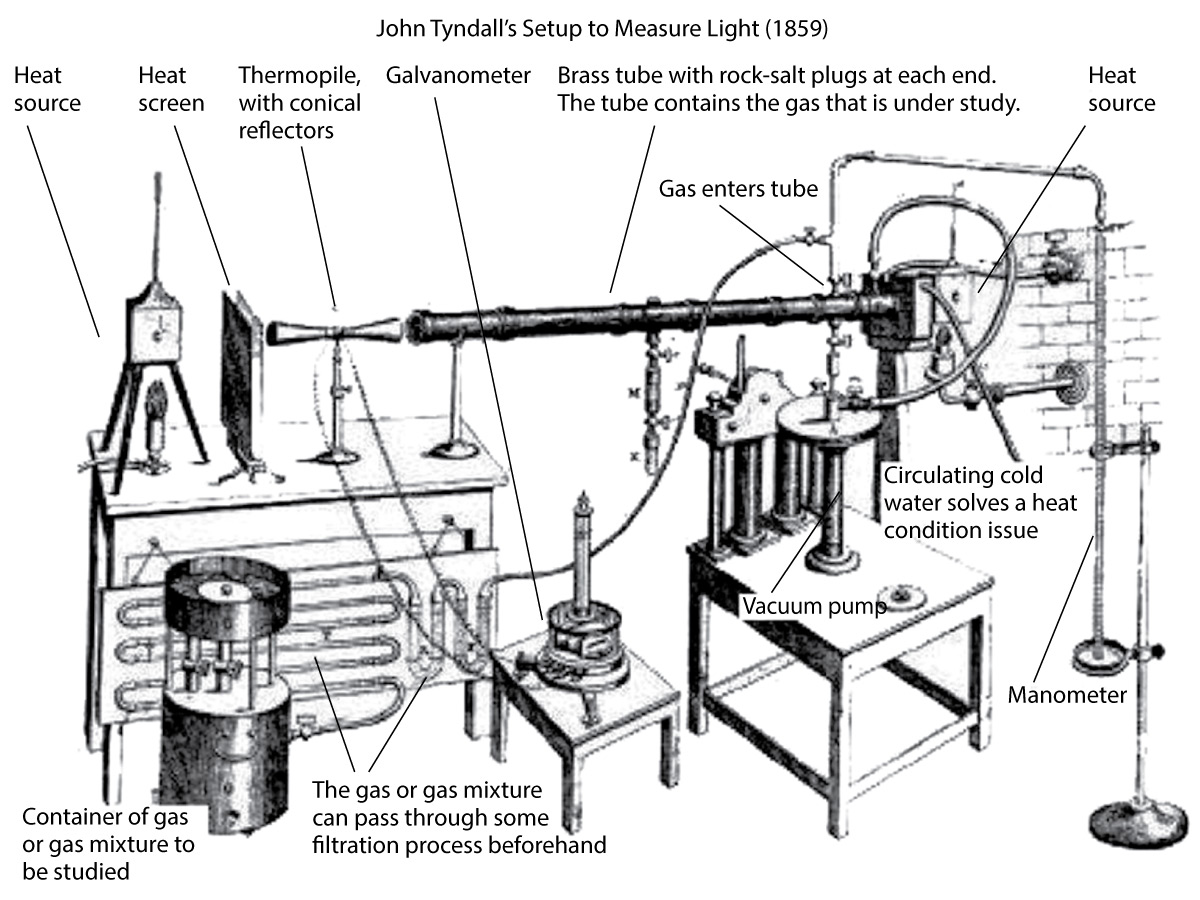
Keep in mind that not all gases are greenhouse gases. For example, the nitrogen and oxygen that make up most Earth’s atmosphere are not greenhouse gases and therefore have essentially no effect on our planet’s temperature. Earth’s naturally occurring greenhouse effect comes entirely from gases that make up only a tiny fraction of the atmosphere. Again, the three most important greenhouse gases in Earth’s atmosphere are carbon dioxide, methane, and water vapor.
Activity
Eunice Newton Foote
Until fairly recently, science historians had credited John Tyndall’s 1859 experiments as the first to establish the idea of the greenhouse effect (though it did not get this name until decades later). Then, in 2011, a researcher came across a reference to the earlier work of Eunice Newton Foote. In fact, Foote had conducted experiments and published a paper on the topic that was presented at the 1856 conference of the American Association for the Advancement of Science (AAAS).
Read this article about Eunice Newton Foote and her work. You may also wish to conduct a brief web search to find other articles about her. (There’s also a short film that has been made about her.) Then, as a group, discuss the following questions:
- Why was Foote’s paper at the 1856 conference read by Joseph Henry rather than by her?
- Do you think Henry gave appropriate credit to Foote when he read her paper? Defend your opinion.
- As noted above and in the article, Foote’s work was “forgotten” for more than 150 years, and as a result people generally credited John Tyndall rather than Foote with the first work on the greenhouse effect. Do you think her work was “forgotten” accidentally or on purpose? Defend your opinion.
- Discuss some of the barriers that Foote must have faced in doing scientific work at that time. How do you think that affected her? Do you think it played a role in her work toward pushing for voting rights for women?
- Some people have tried to claim that global warming is some sort of hoax that was invented only recently. How does the story of Eunice Newton Foote counter such claims?
This activity focuses on the “forgotten” story of Eunice Newton Foote. Be sure that students actually read the article that we link to before engaging in the discussion. Some students may be interested in doing additional research on this remarkable woman, though relatively little is known about her life. Notes:
- If you can work with a colleague teaching social studies, you might suggest having this activity done in that class, where the teacher could put it into a more general context of women’s rights and discrimination.
- The answer to question (1) is simple: as a woman, she wasn’t allowed to present her own work. For questions (2) through (4), students should discuss what they learned in the article and then discuss and defend their opinions clearly.
- For question (5), the key point is that Foote at least recognized the possibility of what we now call global warming way back in 1856. She probably did not consider it an actual danger, since at the time there was no evidence that humans could cause the carbon dioxide concentration to rise. However, the fact that she already understood the concept is a powerful counterargument to those who have tried to claim that global warming is a hoax created recently to further some modern agenda.
Planetary Evidence
The second line of evidence comes from testing our models with actual worlds. We can summarize it like this:
- If there were no greenhouse effect, a world’s average temperature would depend only on its distance from the Sun and the relative proportions of sunlight that it absorbs and reflects. It is very easy to calculate the temperature that a world would have in this case (see the Do the Math box below), and the calculations agree for worlds that lack atmospheres (and therefore lack greenhouse gases), such as the Moon and Mercury. However, this simple model always underestimates the temperatures of worlds with greenhouse gases in their atmospheres, such as Venus or Earth.
In fact, this “no greenhouse” model shows that without greenhouse gases, Earth’s temperature would be well below freezing (about −16°C). - When scientists instead create models that include the greenhouse effect, based on the laboratory measurements of how greenhouse gases work and the amounts of these gases in the atmospheres of different worlds, then the predicted temperatures match the actual, observed temperatures. Note that these models are quantitative , meaning that they give precise, numerical predictions, and they correctly predict the temperatures not only of Venus and Earth, but of every world in our solar system with an atmosphere.
Key Concepts: Evidence for the Greenhouse Effect
There is no scientific doubt that the greenhouse effect really does explain the temperatures of planets like Venus and Earth. We know this both because of laboratory measurements that show precisely how greenhouse gases affect light and because models that include these measurements are the only models that can successfully predict the temperatures of all the worlds in our solar system.
A few additional notes for your background and in case questions arise:
- We show the mathematics of the “no greenhouse” model in the Do the Math box below, because it uses only fairly simple algebra (such as taking a fourth root). We do not show models that include the greenhouse effect, because these are more complex.
- Models including the greenhouse effect do indeed make quantitative predictions that agree with observations for every planet in the solar system (even for the temperatures at different depths in the atmospheres of Jupiter, Saturn, Uranus, and Neptune) and for Saturn’s moon Titan, the only moon with a significant atmosphere.
- Despite what you may read on some “skeptic” web sites, no other models work. For example, one fairly common “skeptic” claim tries to attribute Venus’s high temperature to its high atmospheric pressure alone. However, quantitative models show that this idea does not work (see this reference if you are interested in the mathematics); only the greenhouse effect can successfully account for Venus’s high temperatures and the temperatures of all the other worlds in our solar system with atmospheres (including Earth).
Discussion
The Greenhouse Effect as Fact and Theory
Recall that we can consider gravity to be both a fact and a theory (see Section 3.4.1). Briefly discuss how we can also think of the greenhouse effect as both a fact and a theory. Then imagine that someone were to say to you, “I don’t believe the greenhouse effect is real.” How would you try to convince them that it is?
This can be a very brief discussion, as it is intended primarily just to reinforce the ideas we’ve just discussed. Notes:
- The greenhouse effect can be considered a “fact” in that, as we’ve discussed, there is simply no scientific doubt that it really does make planets warmer than they would be otherwise.
- The greenhouse effect is a theory in the sense that it is understood through a detailed model that is based on laboratory measurements of exactly how greenhouse gases interact with different wavelengths of light. This model rises to the level of a scientific theory because it has proven so successful in explaining planetary temperatures.
- For countering a claim that it isn’t real, students should be able to clearly explain, in their own words, the two lines of evidence discussed in this section.
Completing the “Tale of Two Planets”
Now that you understand the greenhouse effect, we can complete our “tale of two planets.” The large temperature difference between Venus and Earth is caused by the vast difference in the amount of greenhouse gas — in particular, of carbon dioxide — in their atmospheres.
Earth has only a very small amount of carbon dioxide in its atmosphere. Still, this small amount is very important. As you’ve learned, our planet would be frozen over without a greenhouse effect, so the small amount of carbon dioxide in our atmosphere represents the difference between having a frozen, lifeless world and the teeming life we find on our planet today. In that sense, the naturally occurring greenhouse effect is a very good thing, because we would not be here without it.
Now consider Venus. Recall that Venus has so much atmospheric gas that its surface pressure is 90 times as great as that on Earth, and that this gas consists almost entirely of carbon dioxide (see Table 4.3.1–2). Calculations based on this surface pressure show that, overall, Venus has almost 200,000 times as much carbon dioxide in its atmosphere as Earth . That is why Venus is so hot: Its vast amount of carbon dioxide traps so much heat with the greenhouse effect that it gives Venus a surface temperature of 470°C. Figure 7.1.1–7 summarizes the conclusion to our tale of two planets.
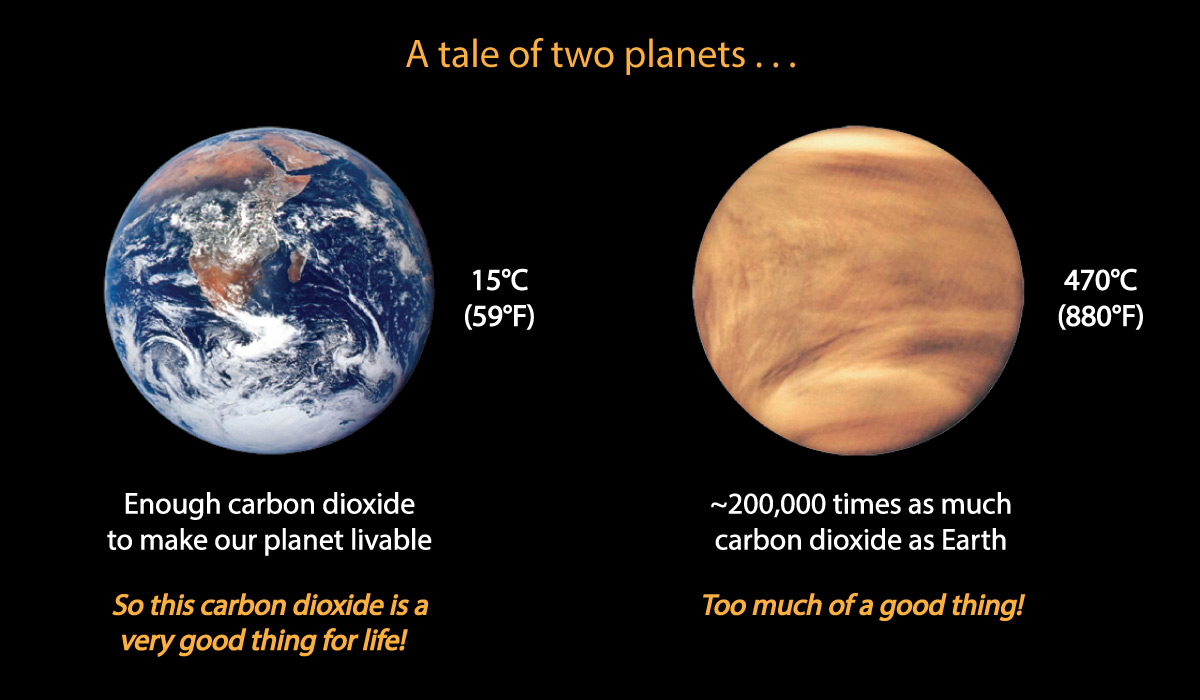
Discussion
Too Much of a Good Thing
We’ve stated that the naturally occurring greenhouse effect is a very good thing for us, because our planet would be frozen without it. In that sense, the case of Venus can be thought of as “absolute proof that it is possible to have too much of a good thing.” Briefly explain what this statement means. How do you think it is relevant to the topic of global warming?
This should be a very brief discussion designed to help set the stage for the next section. The key is for students to recognize that because the greenhouse effect is driven by carbon dioxide on both Venus and Earth, and that Earth has a “just right” amount, Venus is proof that too much can be a problem.
- In terms of global warming, the relevance is that, as we’ll discuss next, humans are increasing Earth’s carbon dioxide concentration, so we must be wary of reaching the point where we have “too much.” Note: There is no danger that human activity could add so much carbon dioxide that our planet would become like Venus, but even at much lesser levels, global warming could create severe consequences (of the types we’ll discuss in Section 7.2).
- This is also an excellent way to debunk claims that global warming is nothing to worry about. Even if there’s no danger of turning Earth into Venus, Venus really does provide proof that more carbon dioxide means higher temperature.
